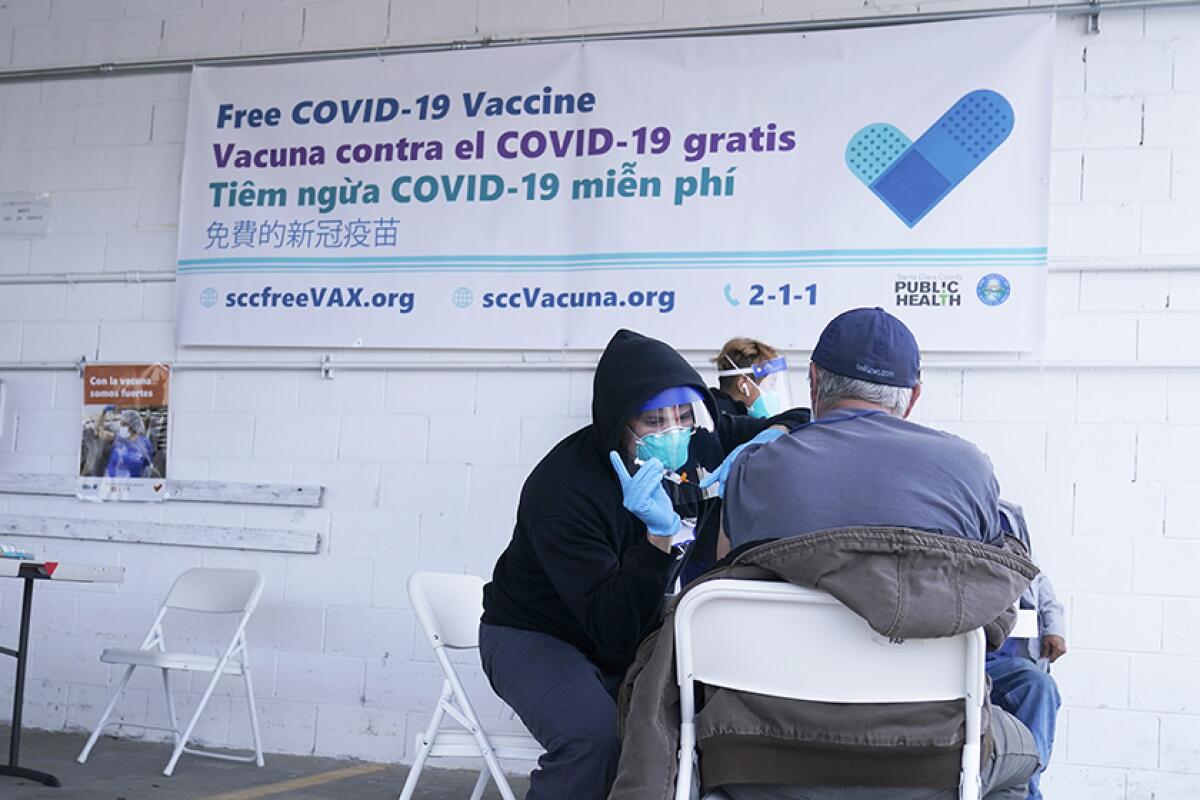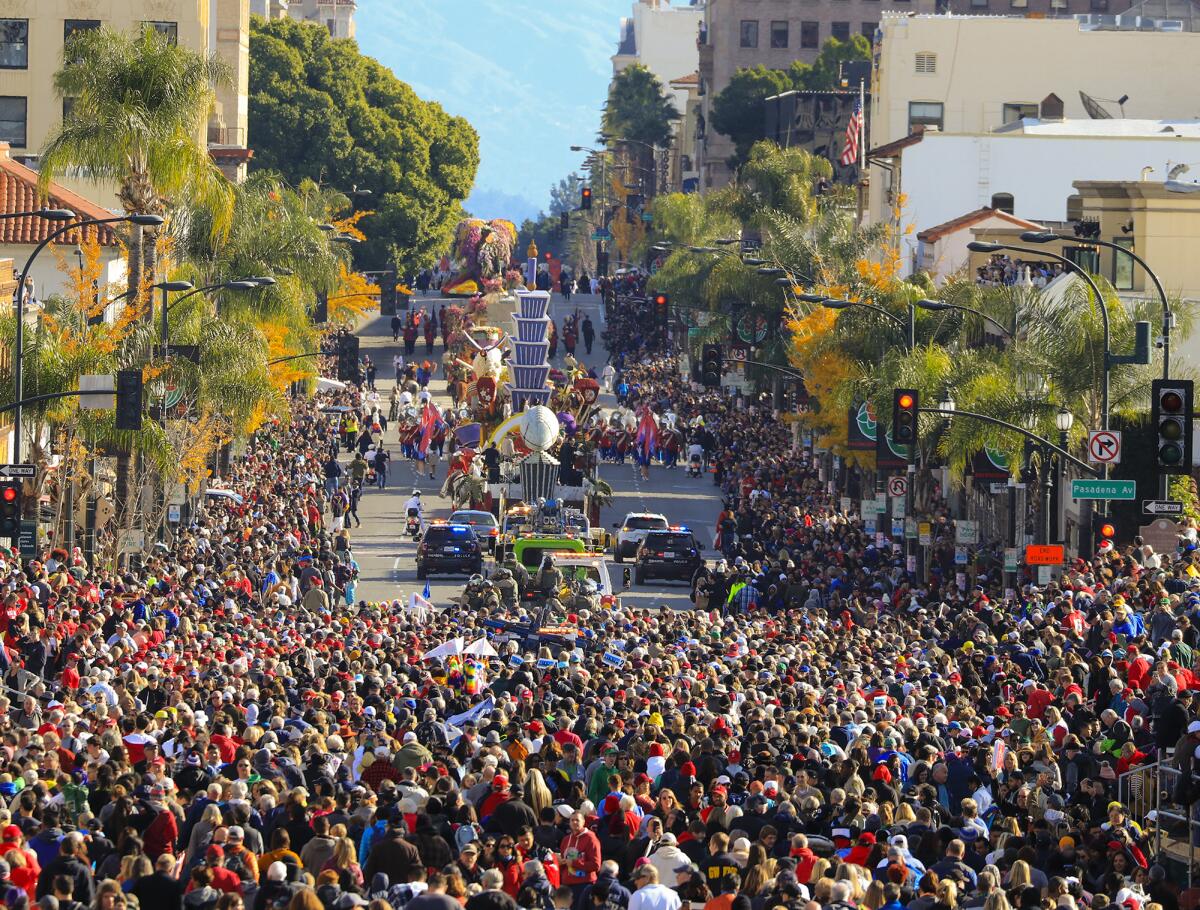Essential California: Shifting vaccine gears, once again

- Share via
Good morning, and welcome to the Essential California newsletter. It’s Friday, March 5, and I’m writing from Los Angeles.
Sign up for Essential California
The most important California stories and recommendations in your inbox every morning.
You may occasionally receive promotional content from the Los Angeles Times.
“An old adage says, ‘Continue to do what you’ve done, you’ll get what you got,’” California Gov. Gavin Newsom said during a press briefing Thursday in Stockton.
The reference came after the governor had recounted some of the state’s efforts to lower the barriers for vaccine access in areas that have felt a disproportionate share of the pandemic’s pain, while also bluntly acknowledging that the state was still “falling short” on the issue. Those disparities in vaccine access have fallen “disproportionately on the Latino community in the state of California,” Newsom said.
The state could continue making small tweaks and improvements to the existing system, but that wouldn’t be enough to bring real and demonstrable progress, the governor said.
As announced late Wednesday night and explained for the first time in detail on Thursday, the state will once again be shifting gears in its pandemic response — this time to dramatically change the way vaccines are allocated.
Officials announced that the state will now devote 40% of available COVID-19 vaccines to residents in the most disadvantaged areas. As my colleagues Luke Money, Soumya Karlamangla and Ron Lin explain in their story, it’s a move aimed not only at addressing the stubborn inequities that have dogged the state’s vaccine rollout, but also at accelerating its reopening.
[Read the story: “California thinks it can stop COVID by flooding poor areas with vaccine. Will it work?” in the Los Angeles Times]
The new strategy won’t change who is currently eligible for vaccines, but rather who will be prioritized within the very large group of Californians in the currently eligible tiers.
The newly announced dedicated 40% allocation will flow toward communities within the lowest quartile of the California Healthy Places Index, a measure of socioeconomic opportunity that takes into account economic, social, education, housing and transportation factors. That lowest quartile encompasses roughly 400 ZIP Codes sprinkled throughout the state, with many in the Central Valley and in and around Los Angeles County and the Bay Area. It has been home to roughly 40% of the state’s COVID-19 cases and deaths, but only about 17% of vaccines have been administered there.
The strategy comes with inherent tradeoffs, as my colleagues report. Reserving a significant slice of the state’s supply means that fewer doses will be available for other groups, at least in the near term. The previously announced dedicated share for educators — 10% of California’s weekly allotment — will also remain in place, meaning half of the state’s doses will be spoken for right from the outset. But officials are also hoping for major boosts in vaccine supply in the coming weeks.
The new effort will directly tie equitable vaccine distribution to further reopenings: Once 2 million doses have been administered in the targeted communities, the state will relax the threshold for counties to advance from the most restrictive category of the state’s four-tier, color-coded reopening plan.
More effectively distributing vaccines in the neediest areas will “give our entire state greater confidence that we’ve protected against the most significant levels of disease transmission in communities that have been, throughout this pandemic, the hardest hit,” California Health Secretary Dr. Mark Ghaly said Thursday.
Questions still remain about exactly how this will work on the ground, particularly because the state’s existing vaccine equity efforts have been dogged by logistical issues. A program intended to provide special appointment access codes to those in the hardest-hit communities was widely misused, with many affluent Californians who would not have otherwise been eligible for vaccination able to secure appointments through the system. Newsom said the state has since transitioned to using individual-use access codes, rather than easily shareable group codes.
“It’s whack-a-mole, every single day,” Newsom said of efforts to ensure that outsiders don’t take advantage of vaccine access programs for the most underserved Californians.
“It’s imperfect,” the governor said.
And now, here’s what’s happening across California:
Note: Some of the sites we link to may limit the number of stories you can access without subscribing.
L.A. STORIES
Rose Parade to return in 2022: Organizers say they are actively planning for the parade’s return in 2022, after the pandemic forced the cancellation of this year’s annual New Year’s Day spectacle for the first time in 75 years. Los Angeles Times

HFPA members voted not to hire a diversity consultant last summer: The disclosure of the internal Hollywood Foreign Press Assn. vote comes as the organization behind the Golden Globes continues to face fierce criticism over a recent Times investigation that, among other things, found there were zero Black journalists among the 87-strong group. Los Angeles Times
Chaos on Canon Drive: One person was shot after three men allegedly attempted to rob a patron at the upscale Beverly Hills Italian restaurant Il Pastaio. Los Angeles Times
Here’s everything Harry and Meghan have done over the last year: A recap of their time in California, ahead of the big Oprah interview on Sunday. Los Angeles Times
Support our journalism
POLITICS AND GOVERNMENT
Weekly federal COVID-19 unemployment will end in August: The weekly federal subsidy issued on top of state benefits will no longer be stretched through September, as some Senate Democrats had requested. Los Angeles Times
More fallout from the San Francisco City Hall corruption scandal: San Franciscans will recoup nearly $100 million in overpaid trash-collection fees after a probe by the city attorney’s office detailed how the waste management company Recology improperly hiked its prices over the last four years. Former Public Works Director Mohammed Nuru — the man at the center of the City Hall scandal — played a key role in setting the rates. San Francisco Chronicle
“Where is Tony Thurmond?” The state schools chief has stayed behind the scenes in the reopening debate. Cal Matters
CRIME AND COURTS
A San Francisco TV reporter was robbed at gunpoint while filming a story on crime: “Isn’t that ironic? Of all the things, literally, we’re doing a report on a crime in [the] neighborhood and we get held up at gunpoint,” the reporter said. SFGATE
HEALTH AND THE ENVIRONMENT
California’s My Turn COVID-19 vaccination appointment system is riddled with flaws that are making it difficult for counties to reserve vaccine appointments for targeted populations, according to local officials. Los Angeles Times
CALIFORNIA CULTURE
California museums are starting to reopen. Here’s the list. Los Angeles Times
Less than 30% of Black Fresno County residents own homes. A nonprofit hopes to change that. Fresno Bee
Who really writes Twitter’s “Trending” summaries? “We’re attempting to — I’m trying to find kind of a polite way of putting it — we’re attempting to remove the ‘WTF?’ from the trending tab.... Our goal is to give you the gist so you’re not spending five minutes looking at the trend trying to figure out what it even means.” OneZero
A poem to start your Friday: “The Mower” by Philip Larkin. Poetry Foundation
Free online games
Get our free daily crossword puzzle, sudoku, word search and arcade games in our new game center at latimes.com/games.
CALIFORNIA ALMANAC
Los Angeles: sunny, 73. San Diego: sunny, 70. San Francisco: partly sunny, 63. San Jose: partly sunny, 68. Fresno: partly sunny, 75. Sacramento: partly sunny, 66.
AND FINALLY
Today’s California memory comes from Pati Brown:
Westminster, Orange County, was vast strawberry fields in the 1960s. One evening my mom drove to meet my aunt at one of the few grocery stores. As they drove home together (only a mile or two) the fog descended to zero visibility. My aunt got out of the car, took off her petticoat, using it as a signal flag, she walked the center divide, guiding my mother and her car through the fog back home.
If you have a memory or story about the Golden State, share it with us. (Please keep your story to 100 words.)
Please let us know what we can do to make this newsletter more useful to you. Send comments, complaints, ideas and unrelated book recommendations to Julia Wick. Follow her on Twitter @Sherlyholmes.
Sign up for Essential California
The most important California stories and recommendations in your inbox every morning.
You may occasionally receive promotional content from the Los Angeles Times.




